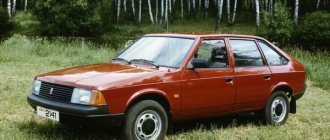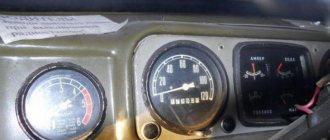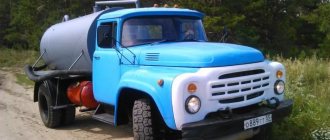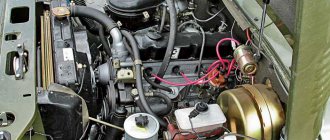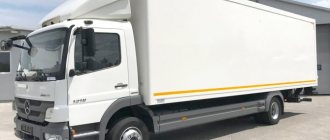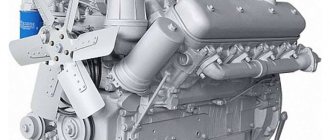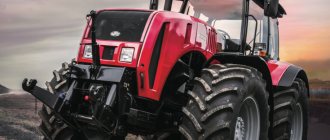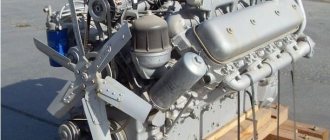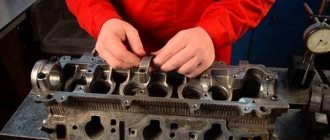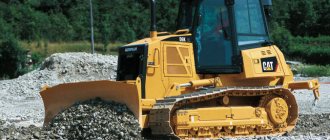06/28/20151-2 tons, 100 - 200 hp, 4×2, 4×4, GAZ, up to 100 hp. s., Van4,276 Views
GAZ-2705 (“Gazelle”) is a popular family of passenger and trucks, the production of which started at the Gorky Automobile Plant in 1995. The model was designed for transporting light weight cargo and was perfect for running a small business. The development turned out to be very successful and fully justified itself. The demand among private entrepreneurs for this model remains very high even now.
General information
The history of the GAZ 2705 series is inseparable from the history of the entire GAZelle family of cars. In the summer of 1994, employees of the Gorky Automobile Plant launched production of the first GAZelles. Almost simultaneously with this, production of the GAZ 2705 van began. The project itself took on large-scale forms in a short time. Van production opened in several countries at once. The reason for this was the huge demand for compact, economical and very cheap carriers intended for medium and small businesses.
The first GAZ 2705 cars appeared on the roads at the beginning of 1995. Almost immediately they managed to become the undisputed leaders of their segment. The car received an all-metal body and a streamlined front, which was loved by many. Four doors (rear 2-leaf hinged with an opening angle of 180 degrees, sliding on the starboard side and 2 front) made it easy to get inside. The cargo compartment was not equipped with glass. The vans were distinguished by ease of maintenance, many available modifications, unpretentiousness and significant maintainability. The first versions of the GAZ 2705 could not be called ultra-reliable, but the low cost forced many to choose this model. The exterior of the van turned out to be quite modest. It was characterized by a large radiator grille, uncomfortable mirrors that left large “dead” zones, and simple rectangular optics.
Later, the Gorky Automobile Plant began production of cargo-passenger variations of the GAZ 2705 (“combi”), which finally made the model a leader in its class in terms of sales volumes. The new modification was somewhat different from the van. She received additional viewing windows on the side. They were installed near the second row of seats. Structurally, the models were identical.
Over time, GAZ 2705 has gone through several changes. The developers slightly adjusted the appearance of the model, which acquired enlarged side mirrors with integrated turn signal repeaters (specialists in this case took into account the problems that drivers had due to poor visibility), more interesting teardrop-shaped optics, a modernized plastic bumper and a redesigned larger radiator grille. This modification is currently being produced at the plant.
In 1996, the GAZ 27057 van, characterized by increased cross-country ability, was produced in small series. Since 2002, versions of the GAZ 27057-90 and GAZ 2705-90 have been produced in limited quantities, equipped with an add-on plastic roof, due to which the height of the cargo compartment is increased to 1850 mm, the useful volume is up to 11 cubic meters. Based on the basic version of the GAZ 2705, many specialized vehicles have been developed for a variety of purposes (collection armored vehicles, ambulances, auto laboratories and other modifications).
GAZ 2705 is aimed at small commercial organizations. The van has a considerable carrying capacity, which allows it to be used in central areas of the city. If you need to transport a large group of passengers and a consignment of cargo at the same time, then the best option would be the GAZ 2705 “combi”. Its carrying capacity is less than that of a van, but the 2-row operator's cab allows you to transport 6 people (regular version - 3 people). The metal compartment protects the cargo well from dirt, dust and adverse climatic conditions. The model is adapted to difficult Russian conditions, which is an additional advantage.
This is interesting: Volkswagen transporter (T3, T4, T5) - technical characteristics
Flaws
As you can see, the fuel consumption of the car is not very high. Of course, the actual fuel consumption of the Sobol 2217 may differ from the data indicated above. Since they correspond to the passport data of Sobol Barguzin. Actual fuel consumption may depend on many factors not related to the vehicle itself. This includes the quality of the fuel, the driver’s driving style, and the amount of traffic jams on the road if you drive around the city.
Briefly about the main thing in GAZ 2217 2.5 l
- body type – minivan;
- number of doors – 4;
- engine capacity – 2.46 liters;
- engine power – 140 horsepower;
- injection distributed fuel supply system;
- four valves per cylinder;
- rear wheel drive car;
- five-speed manual transmission;
- maximum speed – 120 km per hour;
- acceleration to 100 km per hour occurs in 35 seconds;
- average fuel consumption of GAZ 2217 on the highway is 10.7 liters;
- Fuel consumption rate for GAZ 2217 in the city is 12 l;
- fuel consumption on the GAZ 2217 per 100 km with a combined cycle – 11 l;
- fuel tank with a volume of 70 liters.
As you can see, the fuel consumption of the car is not very high. Of course, the actual fuel consumption of the Sobol 2217 may differ from the data indicated above. Since they correspond to the passport data of Sobol Barguzin. Actual fuel consumption may depend on many factors not related to the vehicle itself. This includes the quality of the fuel, the driver’s driving style, and the amount of traffic jams on the road if you drive around the city.
GAZ is one of the most famous Russian automobile companies
. Its cars are known not only in Russia, but also far abroad. To ensure that their cars are competitive, the company is constantly improving its products, so when you buy Sable Barguzin, you will receive a domestic car of unsurpassed quality with low fuel consumption.
Fuel consumption on different Gazelle models
Since 2010, the Gorky Automobile Plant has been actively implementing all the wishes of car owners of the classic model of the Gazelle line. New car models appeared that could best meet the requirements of drivers and entrepreneurs and fulfill all the assigned tasks. Fuel consumption directly depends on the Gazelle model, the type of internal combustion engine, engine size and vehicle load.
Gas 2217
Sobol minibuses are actively used not only for commercial purposes. They serve the state, emergency and municipal services of Russia. In terms of technical characteristics, Sobol is not inferior to competitors from abroad. The main function of the 2217 is to transport passengers; there are six, eight and ten-seater models, but if the owner wishes, it is possible to install a cargo van.
Fuel consumption for a 2.9 engine with a power of 115 hp. on gasoline:
- urban areas - 10.5 liters;
- highway - 8.5 liters;
- mixed terrain - 9.5 liters.
Diesel fuel consumption for a 2.1-liter engine with a power of 95 hp. With.:
- for the city 12 liters;
- on the highway 10.7;
- mixed consumption 11 liters per 100 km.
Engine with a volume of 2.8 liters and a power of 128 hp. running on diesel fuel will consume:
- 8.5 liters in the city
- 7 liters on the highway
- 8 liters for combined trips.
Gas 2705
Light-duty trucks, the advantage of which is that category B drivers can drive them, the “Truck traffic prohibited” sign does not apply to Gas 2705. The model is universal and mobile in operation. Equipped with rear hinged doors and side doors for maximum comfort in loading different types of cargo.
The Gas 2705 Combi model has become a real find for car owners, as it combines passenger seats and a cargo compartment. A universal all-metal van is capable of protecting transported cargo from damage and external influences. The passenger part of the car is comfortable and seats six.
For an engine with a displacement of 2.9 and a power of 107 hp, gasoline consumption will be as follows:
- For city roads - 14.1 liters;
- For the highway – 10.7;
- Combined consumption is 11.5 liters per 100 km.
If Gas 2705 is equipped with a 2.8 liter engine with a power of 120 hp, diesel fuel consumption will be:
- 12 liters for the city;
- 9.2 for the highway;
- 10 liters for mixed types of roads.
Gas 2752
The most popular vehicle for delivering cargo in large cities. It has good maneuverability, combining small size and a carrying capacity of up to 1 ton. The Sobol models combine comfortable passenger seats and a spacious luggage compartment with a height of more than one and a half meters. Gas 2752 meets all modern equipment, comfort and environmental requirements for this class of car.
Average gasoline consumption is 11.5 for combined driving on highways and city roads. For diesel fuel this figure will be 9.8 liters per 100 km.
Gas 27527
To allow the car to pass in more difficult road conditions, Gas 27527 was created. The model is all-wheel drive and boasts a 2.8-liter Cummins turbocharged diesel engine. Like its brother Gas 2752, model 27527 was equipped with power steering, improved maneuverability and permanent all-wheel drive. It copes remarkably well with driving on roads that are not of the best quality. “Sables” are very easy to maintain; not only do they save your wallet when purchasing, they are repairable, spare parts for them are freely available and at low prices.
According to factory technical data, Sobol's gasoline consumption at a speed of 60 km/h is 8.5 liters, over 80 km/h 10.5 liters. But according to real reviews from car enthusiasts, the Gazelle has a larger appetite - and in urban areas it consumes 12 liters, and on the highway 11 liters. Diesel fuel consumption for this model is about 9.8 liters per 100 km.
Gas 3302
An excellent solution for transporting construction crews and special equipment. The main advantages include significant fuel savings. The load capacity already reaches 1.5 tons, which makes this model an indispensable assistant on construction sites and in production.
Modifications that are older than 10 years are characterized by increased fuel consumption. For gasoline with a 2.9 engine with a power of 107 hp. average fuel consumption:
- 21.6 liters in the city;
- 17.4 on highways;
- 19 liters combined.
In “younger” models (especially with a Cummins installation), fuel consumption for mixed trips is about 10 liters per 100 km.
Diesel fuel consumption averages from 17 to 19 liters.
Gazelle Next
The latest development of the Gorky Automobile Plant. A medium-duty truck that meets modern business requirements. The model is equipped with electric windows, electric mirrors, and central locking as standard.
Fuel consumption is significantly reduced compared to Gas 3302 for gasoline:
- 15 liters for city roads;
- 12 liters for the highway;
- 13.5 for mixed type roads.
For diesel fuel consumption:
- 12 liters – city;
- 9.5 liters – highway;
- 11.1 liters – for combined driving.
Gazelle Business
The first model after the start of modernization of Gazelles. Compared to the classic model, the Business was equipped with a new body design and unique color schemes. The manufacturer has worked hard on the quality of the seats and the technical characteristics of the model.
The manufacturer's fuel consumption standards are again underestimated:
- for the city 12.5 liters;
- for the highway 10.4;
- in the combined cycle 11.9 liters.
But experienced motorists claim that the consumption of a new car will differ from the manufacturer’s standards by 10-15%.
GAZ buses until 2008
| Model | Fuel consumption rate per 100 km | Type of fuel |
| GAZ-22171 “Sable” (7 seats) | 10,2 | B |
| GAZ-22171-0 “Sable” (7 seats) (ZMZ-4063-4L-2.3-110-4M) | 16,7 | B |
| GAZ-22175 "Barguzin" (11 seats) | 14,5 | B |
| GAZ-22177 (7 seats) | 15,6 | B |
| GAZ-3221 (9 seats) (UMZ-4215-4L-2.89-96-5M) | 17,4 | B |
| GAZ-3221 (9 seats) | 16,5 | B |
| GAZ-3221 "Gazelle" (9 seats) | 18,8 | B |
| GAZ-3221 "Gazelle" (9 seats) (ZMZ-4025.10-4L-2,445-90-5M) | 17,9 | B |
| GAZ-3221 "Gazelle" (9 seats) | 17,9 | B |
| GAZ-3221 "Gazelle" (9 seats) | 16,9 | B |
| GAZ-32213 (13 seats) (ZMZ-406300-4L-2.3-110-5M) | 16,4 | B |
| GAZ-32213 (13 seats) | 11,8 | D |
| GAZ-32213 "Gazelle" (13 seats) | 16,9 | B |
| GAZ-32213 Diesel Turbo (13 seats) | 11,0 | D |
| GAZ-322132 (13 seats) | 16,2 | B |
| GAZ-322132 (13 seats) | 15,8 | B |
| GAZ-322132 (13 seats) | 15,5 | B |
| GAZ-322132 (13 seats) | 17,6 | B |
| GAZ-322132 (14 seats) | 17,9 | B |
| GAZ-322173 (14 seats) | 18,2 | B |
What other factors does fuel consumption depend on?
Fuel consumption figures are very average; when calculating fuel consumption, it is important to consider the following:
- Seasonality. In winter, fuel consumption is higher due to the engine warming up during operation.
- Condition of the road surface. On a suburban highway, the reason for the increased consumption may be ups and downs on the road. In the city, constant stops and sudden braking increase consumption.
- Cargo. The more the car is loaded, the greater the fuel consumption will be.
- Low tire pressure. Fuel consumption increases to overcome high resistance.
- Model. The all-wheel drive model requires higher gasoline or diesel consumption.
Diesel or gasoline
If Gazelles are used as “workhorses” and transport cargo, the optimal solution would be to choose diesel fuel. Diesel fuel costs less, diesel fuel is cheaper – it’s more profitable.
If, after all, the owner opted for gasoline, then to save money, many install the car with injection.
Engine capacity
The engine volume speaks for itself about the amount of fuel it can hold. Accordingly, the larger the engine volume, the greater the consumption, but also the more powerful the Gazelle.
How do you drive
Fuel consumption directly depends on driving technique:
- If a driver likes to maneuver on the road, go around cars, brake sharply and take off, he risks adding about 1% to his consumption.
- High speed and skidding on the roads also increase fuel consumption.
Breakdowns and malfunctions
If the car has a breakdown, but it remains on the move, other mechanisms need to work hard, replacing the functions of the broken part. Often, when an internal combustion engine malfunctions, fuel literally flies down the drain.
How do you drive
Driver's driving style. Each driver is used to driving his vehicle differently, so it may turn out that the car covers the same distance along the highway, but in the end the mileage is greater.
This happens because many drivers like to overtake other motorists and weave in and out of lanes. Due to this, additional kilometers are added to the counter. In addition, fuel consumption can be affected by the habit of starting and braking too sharply, driving fast, going into skids - in this case, the consumption of liters increases.
Model features
GA3-2705 vehicles are aimed at meeting the needs of small and medium-sized businesses. The van has a small carrying capacity, which allows it to be used in central areas of cities, and to drive such a truck, a “passenger” category “B” is sufficient. GAZelles are not subject to the traffic regulations sign 3.4 “Traffic traffic is prohibited” (if the sign does not have an additional designation of the vehicle’s weight). GA3el cars belong to class N1 (M2) with a permitted maximum weight not exceeding 3500 kilograms.
In addition to two cabin doors, the car is equipped with two cargo doors - a side sliding compartment door and a rear double-hinged door that opens 180 degrees.
For those organizations that need to transport both a small group of passengers (for example, a work crew) and a consignment of cargo at the same time, the cargo-passenger GA3-2705 (combi option) has become the optimal option. The all-metal compartment of the van protects the cargo well from dirt, dust and adverse climatic conditions. These trucks demonstrated good adaptation to the difficult conditions of imperfect domestic roads and decent endurance.
Initially, the all-metal GA3el vans received a rather modest exterior and interior – with simple rectangular optics, a radiator grille and side mirrors that left significant “dead zones”; an angular dashboard made of cheap plastic and interior trim with other economy-class materials.
In 2003, the GA3el family was restyled. The new cars were noticeably different in appearance from the earlier series with a new tail, radiator grille, bumper and lighting equipment (before restyling, the headlights were rectangular, after they became streamlined, teardrop-shaped). The side mirrors have become larger, complemented by integrated turn signal indicators. Since February 2010, production of an improved version of the car began, called “GA3el Business” (the second restyling of “GA3el”). The number of modifications of GA3-2705 / “GA3el Business” is ten: cargo and cargo-passenger; with petrol, diesel and gas engines.
The cargo version of the van does not have glazing. Additional viewing side windows are installed only on cargo-passenger versions of the “combi” - for passengers of the second row of seats. The cargo-passenger version, which is no different from a van according to the basic industry index, is equipped with an additional seat for four passengers and a solid partition separating the cabin from the cargo compartment.
Among the unusual modifications of this family are the GA3-27057 all-terrain van, as well as the GA3-2705-90 and GA3-27057-90 variants: with an add-on plastic roof, increasing the internal height of the cargo compartment from 1515 to 1850 mm and its useful volume from 9- from m³ to 11 m³.
First generation (1995-2003).
Based on the basic version of GA3-2705, many special vehicles were developed for various highly specialized purposes (cash-in-transit armored vehicles, ambulances and intensive care vehicles, auto laboratories, etc.)
Since 2013, the production of GA3el trucks of a new generation began: GA3el-Next. The car inherited the frame, gearbox and rear axle from the “classic” GAZelle. The classic "GAZelle" family also remained in the production program of the Gorky Automobile Plant, and after the release of the new "Next" family, it received a number of improvements and the name "GA3el Business"
Generations of Cummins ISF2.8 engines: Euro-3/4/5. Differences.
- EURO-3. In the Russian Federation, the standard was introduced in 2008. This standard is achieved only by the operating process of an engine with an electronically controlled injection system (Common Rail) and does not require any additional exhaust gas cleaning systems. This was the basic and simplest ISF2.8. — no exhaust gas recirculation (EGR) systems, throttle valves, or mass air flow sensors.
ISF2.8S3
ISF2.8S3 In the pictures above, the Euro-3 version does not have an EGR system (exhaust gas cooler, exhaust gas recirculation pipe, no throttle valve at the inlet.
On the GAZelle, this engine came in the 129 hp/255 Nm version. The torque was software limited to 255 Nm to avoid premature damage to the gearbox, although by switching one checkbox in the settings, we could immediately get 310 Nm.
Euro-3 engines came only with this power rating
2. EURO- 4 . In the Russian Federation, the standard was introduced in 2014.
All commercial vehicle manufacturers in the Russian Federation spent 2012-2013 adapting to these changes, and there were a lot of changes. The discussion was about a global transition to the Euro-4 standard: engines were being tuned, vehicles that were planned to be produced in 2014 were modernized and certified.
The Euro-4 standard provides for a reduction in nitrogen oxides (NOx) and particulate matter (soot, PM) by approximately 2 times relative to Euro-3. And here it is impossible to meet the standards by work process alone. Accordingly, an exhaust gas purification system was required - EGR (exhaust gas recirculation).
At this stage, a USR valve, an exhaust gas cooler, a recirculation tube, a mass air flow sensor (mass air flow meter) for isolating fresh air flow from the total volume and a throttle valve appear in ISF2.8 (although there were options without it). The essence of the EGR system is that part of the exhaust gases is returned to the intake. This is required in order to reduce the temperature of the working process in the combustion chamber and thus reduce NOx emissions (although at the same time, the amount of soot that does not burn at low temperatures increases inversely). In other words, we deliberately worsen the quality of the work process and increase fuel consumption for the sake of environmental standards.
It is not difficult to notice that in the Euro-4 version additional elements have appeared: 1 - USR cooler 2 - recirculation pipe 3 - throttle valve The letter R has appeared in the name ISF2.8S4 R 129, denoting Recirculation (EGR).
Until 2015 inclusive, these engines had firmware similar to Euro-3: 129 hp/255 Nm and had a number of childhood problems (the most basic one was a leaking EGR cooler), which were corrected in the “restyling”:
After the “restyling” of 2015, the installation of a reinforced gearbox on GAZelle Next, Cummins ISF2.8 engines came with firmware for 148 hp/330 Nm.
Such an engine “drove” much more interestingly
On Nexta, starting in 2016 (2015 was a transition year), a lot of design improvements have been introduced. The main ones are:
- improved design of the USR heat exchanger, which has stopped leaking.
- modified design of the oil pan (a massive defect with a delaminating oil intake tube has been eliminated)
3. EURO- 5 . In the Russian Federation, the standard was introduced in 2022.
Initially, the government planned to introduce the standard in 2016, but due to a wave of indignation from automakers, it postponed the adoption of the standards until 2022. This standard once again provides for an almost twofold reduction in NOx emissions and, most importantly, soot should be 5 TIMES less than E-4 and 10 times less than E-3.
And here the work on remaking the engine is much more global. Previously, it was generally believed that it was impossible to achieve the Euro 5 level using the EGR system and it was necessary to switch to SCR (urea injection). But, nevertheless, we were able to achieve it using EGR. What needed to be done: in addition to the EGR system, a variable geometry turbocharger (Borg Warner) and a DPF (diesel particulate filter) were added. In addition, the cars have a closed crankcase ventilation system (crankcase gases go back into the engine intake, and not into the atmosphere as before).
In general, there are much more design improvements in this generation of engines than might seem at first glance.
The photo above clearly shows the drive system for changing the geometry of the turbocharger, as well as the modified design of the USR valve.
DPF - Diesel Particulate Filter
The same particulate filter with a differential pressure sensor, based on the readings of which the condition of the filter and the need to burn it are assessed.
Euro-5 modifications for trucks come in the 150hp/330Nm version. Rated power 150hp. achieved at 3400 rpm.
Euro-5 modifications for Sobols and frame buses (minibuses) come in the 129hp/255Nm version. The VSH charts can be found above.
If we talk about the potential of these engines, then they all drive great, with skillful adjustment of the calibrations. But, nevertheless, the Euro-4 version has the greatest potential. This engine produces more than 550 Nm and 200 hp without any problems.
459.6 lb ft or 620 Nm and 207 hp. at 2360 rpm
Where are Cummins ISF2.8 engines used?
Contrary to the popular belief that, supposedly, somewhere there is a market where there are a lot of Cummins 2.8 diesel engines - the main market is precisely the Russian GAZ plant. Gazelle was the very first serial
History of creation and brief description of ISF2.8
The ISF2.8 is a four-cylinder supercharged diesel engine produced at the Chinese BFCEC (Beijing Foton Cummins Engine Company) plant, a joint venture between Cummins and Foton. This is not a Chinese motor, contrary to popular belief, produced according to
Purpose
The Gazelle car has a large number of modifications and is quite picky both to the quality of the spare parts used and to the operating conditions. Its modifications include:
- "Gazelle Business" has a closed body, which is considered a cargo compartment.
- “Gazelle-Farmer” is a modification in which, instead of a rear cargo part, there is a connected trailer, which makes this vehicle look like a pickup truck.
- The Gazelle minibus is equipped with glazing in the rear windows and additional passenger seats instead of a cargo compartment.
- ASMP "Gazelle" is used in ambulances and is equipped with all kinds of electronics to support human life.
The car is even available in all-wheel drive versions, which gives you the opportunity to choose it to suit your needs and satisfy the technical needs of even the most demanding buyer.
The Gazelle has retained its small size to this day. The car has a unibody body. The base model has two regular doors, one sliding type, which is located on the right side of the car, and a rear door consisting of two doors for opening. Windows in the cargo compartment are installed only in passenger versions of the GAZ-2705. The front part is rounded, which makes the car's speed characteristics quite acceptable in its class.
This is interesting: GAZ 32213: technical characteristics, interior, cabin
Device Features
The base GA3-2705 is based on a frame chassis (unlike many analogues from other manufacturers, where the body is load-bearing). At the front there is a dependent suspension with telescopic hydraulic shock absorbers and longitudinal semi-elliptic springs. At the rear there is a dependent suspension on 2 semi-elliptic springs. It is additionally reinforced with a spring block and a beam - anti-roll bar. Telescopic type hydraulic shock absorbers are also used here.
GA3-2705 after restyling in 2003.
All modifications of GA3-2705 use a standard brake system with two independent circuits; with vacuum booster and hydraulic control drive. Ventilated disc brakes are installed on the front wheels, self-adjusting drum brakes are installed on the rear wheels. The braking system itself is of an independent type and diagonal action. The parking brake is a cam cam located on the rear wheels.
The wheel formula of the basic all-metal van GA3-2705 is “4x2”, with rear axle drive, but a number of modifications are equipped with permanent “4x4” all-wheel drive, based on a center differential.
The GA3-2705 steering mechanism operates on the “screw-ball nut” principle and in almost all modifications, with rare exceptions, is supplemented with a hydraulic power steering.
4.Transmission
| Clutch | Single disc, dry, hydraulically driven |
| Transmission | Mechanical, 5-speed with synchronizers in all gears |
| Gear ratios: | |
| 1st gear - 4.05 | |
| 2nd gear - 2.34 | |
| 3rd gear - 1.395 | |
| 4th gear - 1.0 | |
| 5th gear - 0.849 | |
| Reverse - 3.51 | |
| Transfer case for 4x4 vehicles | Mechanical, has two gears: high (i=l.07) and low (i=l.87), as well as a symmetrical center differential with forced locking |
| Cardan transmission | Two shafts with three universal joints and an intermediate support Three shafts (for 4x4 vehicles) with |
| six universal joints | |
| Front axle of 4×4 vehicles: | |
| main gear | Hypoid, gear ratio - 5.125 |
| differential | Bevel, gear |
| steering knuckles | With cardan joints of unequal angular velocities |
| Rear axle: | |
| main gear | Hypoid, gear ratio 5.125 - for 4x4 vehicles; 4.3 - for 4x2 vehicles |
| differential | Bevel, gear |
A symbol that replaces the letter of the engine configuration option.
Video review
In terms of technical characteristics, the GAZ-2705 is one of the best in its class and is suitable for almost any consumer. The high-strength frame highway is highly resistant to any type of deformation, which allows the vehicle to be used not only on asphalt roads, but also on dirt roads and off-road. A special all-wheel drive modification of the GAZ-2705 is offered for farmers. Currently, the Gorky Automobile Plant produces over 60 versions of the car, differing in “filling” and overall characteristics.
All-metal vans built on the basis of this vehicle are designed as standard for 3 people. The “combi” design allows you to accommodate up to 6 people (the cabin is separated from the compartment by a blank wall). Increased demand for the model forces the Gorky Automobile Plant to regularly carry out changes and restyling of the car, improving its basic parameters.
Most of the transformations turned out to be minor and concerned individual nodes. So, in the early 2000s, the headlights, radiator and bumper were changed. Major modernization of the GAZ-2705 was carried out twice. Currently, the Gazelle is in its third generation.
Reliable power plants of the Gazelle are combined with a 5-speed synchronized gearbox, created on the basis of a 4-speed gearbox from Volga.
Low cost coupled with low operating costs makes the GAZ-2705 an excellent option for small businesses.
Modifications
The Gazelle brand has long become a symbol of commercial transport in Russia. And since the specifics of light-tonnage transportation require a variety of vehicles, separate modifications of the popular van are created on the basis of the GAZ-2705 model.
In addition to the already mentioned Combi vehicles, since 2010 the Gorky Automobile Plant has been producing the GAZelle-Business, based on the 2705 platform. In addition to the commercial carrier, special vehicles have been developed: an ambulance, a cash-in-transit armored vehicle, a mobile medical laboratory, a hydraulic service vehicle .
Cabin
The cabin of the GA3-2705 vans does not require a large amount of free space, but allows more or less free space for the driver and two passengers - on a double passenger seat. The passenger seat is equipped with two seat belts (one of them is a lap belt) and hard plastic head restraints. Economy class plastic and fabric are used to decorate the cabin (however, in modern versions of GA3-2705/GA3el Business, the quality of finishing materials has noticeably improved).
Dashboard GA3-2705 first generation.
In the cargo-passenger “combi” modifications, the cabin also has a second row of passenger seats for 4 seats. In both cases, the cabin is separated from the cargo compartment by a rigid metal partition.
Specifications
A van with a body of all-metal construction, with a capacity of 6, 9 and 11 cubic meters. Characteristics:
- wheel formula – 4 x 2;
- load capacity – 1350 kg;
- curb weight – 2000 kg;
- front axle load – 1050 kg;
- on the rear axle – 950 kg;
- total vehicle weight – 3500 kg;
- car length, mm – 5500;
- height, mm – 2274;
- width, mm – 2500;
- cargo compartment length, mm – 3214;
- cargo compartment width, mm – 1719;
- cargo compartment height, mm – 1515;
- ground clearance (ground clearance) - at least 170 millimeters;
- wheelbase, mm – 2900;
- track width – front/rear wheels – 1700/1560 mm;
- maximum vehicle speed – 115 km/h; average fuel consumption in city mode – 11.5 l;
- front suspension - dependent, on two longitudinal semi-elliptical springs, with a stabilizer bar providing lateral stability; hydraulic telescopic front suspension shock absorbers;
- rear suspension - dependent, on two semi-elliptic springs, reinforced with a small spring block, with a transverse stability beam; hydraulic shock absorbers, telescopic design;
- front brake – non-ventilated disc;
- rear brake - drum, self-regulating;
- braking system – dual-circuit, independent, diagonal action;
- The parking brake mechanism is a cam eccentric on the rear wheels.
The GAZ-2705 model, whose characteristics fully comply with Euro-3 environmental requirements, is sent abroad in small quantities.
Power point
The GAZ-2705 car is equipped with a ZAZ-406 engine from the Zavolzhsky Motor Plant with the following characteristics:
- type – gasoline, internal combustion;
- power supply – fuel injection;
- number of cylinders – 4;
- location – in-line;
- number of valves – 16;
- power, maximum – 145 hp. With. at 5200 rpm;
- cylinder diameter, mm – 92;
- compression ratio – 9,3;
- piston stroke – 86 mm;
- cooling – water;
- weight – 192 kg.
The GAZ-2705 engine is structurally reliable, has a fairly long service life, and requires minimal preventive maintenance. The only drawback of the motor is its cooling system; the thermostat often has to be changed. The rest of the power unit does not cause any complaints.
Recently, the plant switched to equipping the GAZ-2705 model with CUMMINS engines.
Fuel consumption of GAZ 2705 per 100 km.
The fuel consumption rate of the GAZ-2705 depends on the type of engine installed. At a speed of 60 km/h it is:
- “ZMZ-4063.10” – 10.5 l/100 km;
- “ZMZ-40522” – 9.5 l/100 km;
- "GAZ-560" - 8.5 l/100 km;
- “GAZ-5601” – 8 l/100 km;
- “GAZ-5602” – 8 l/100 km;
- “UMZ-4215.10” – 11 l/100 km;
- “UMZ-4215.10-10” – 11 l/100 km;
- "UMZ-4216" - 11 l/100 km.
At a speed limit of 80 km/h, fuel consumption increases by an average of 2-3 liters.
Transmission
All GAZ-2705 vehicles are equipped with a five-speed manual transmission with full speed synchronization. The unit is an improved version of the four-speed gearbox from the Volga GAZ-24.
Engine
The Gorky Automobile Plant produces about 60 modifications of the GAZ-2705 with various power plant options:
- “ZMZ-4063.10” is a 4-cylinder, 4-stroke carburetor engine with a V-shaped cylinder arrangement and spark ignition. This unit runs on AI-92 gasoline and has a microprocessor ignition system. Displacement – 2.28 l, rated power – 72.2 (98) kW (hp), compression ratio – 9.3. This unit complies with Euro-0 standards;
- “ZMZ-40522” is a 4-cylinder, 4-stroke V-shaped gasoline engine with spark ignition and fuel injection. The motor complies with Euro-2 standards. Displacement volume – 2.46 l, rated power – 104.8 (142.5) kW (hp), compression ratio – 9.3;
- "GAZ-560" is a 4-cylinder, 4-stroke in-line diesel engine with liquid cooling of the charged air, turbocharging and direct fuel injection. The unit complies with Euro-1 requirements. Displacement – 2.13 l, rated power – 70 (95) kW (hp), compression ratio – 20.5;
- "GAZ-5601" is a 4-cylinder, 4-stroke in-line diesel engine with liquid cooling, charge air cooling, direct fuel injection and turbocharging. The power plant meets Euro-2 requirements. Displacement – 2.13 l, rated power – 81.0 (110) kW (hp), compression ratio – 20.5;
- “GAZ-5602” is an analogue of the “GAZ-5601” unit with higher environmental characteristics (compliance with Euro-3 standards);
- “UMZ-4215.10” is a 4-cylinder, 4-stroke, in-line carburetor petrol unit with liquid cooling. The motor complies with Euro-0 standards. Displacement – 2.89 l, rated power – 70.5 (96) kW (hp), compression ratio – 8.2;
- “UMZ-4215.10-10” is a 4-cylinder, 4-stroke in-line carburetor engine. The engine runs on AI-76 gasoline and meets Euro-0 standards. Displacement – 2.89 l, rated power – 65.4 (89) kW (hp), compression ratio – 7.0;
- “UMZ-4216” is a 4-cylinder, 4-stroke gasoline unit with a liquid cooling system. The motor meets Euro-2 standards and has spark ignition. Displacement – 2.89 l, rated power – 102.0 (75.0) kW (hp), compression ratio – 8.2.
The latest versions of the GAZ-2705 are also equipped with a Cummins 2.8s4 engine with improved parameters.
Cost of GA3-2705 cars
In 2022, retail prices of the Gorky Automobile Plant for current modifications of cars - all-metal vans GA3-2705 ("GA3el Business") were as follows: GA3-2705-757 - 4x2; 3 places; gasoline (UMZ-A274Evotech) – 950,000 rubles; GA3-2705-Z57 – 4x2; 3 places; diesel (Cummins) – 1,310,000 rubles; GA3-27057-758 – 4x4; 3 places; gasoline (UMZ-A274Evotech) – 1,010,000 rubles; GA3-27057-Z58 – 4x4; 3 places; diesel (Cummins) – 1,370,000 rubles; GA3-27055-757 – 4x2; 3 places; bi-fuel, with gas equipment – 990,000 rubles; GA3-2705-777 – 4x2; 7 seats; gasoline (UMZ-A274Evotech) – 1,000,000 rubles; GA3-2705-Z77 – 4x2; 7 seats; diesel (Cummins) – 1,395,000 rubles; GA3-27057-778 – 4x4; 7 seats; gasoline (UMZ-A274Evotech) – 1,060,000 rubles; GA3-27057-Z78 – 4x4; 7 seats; diesel (Cummins) – 1,455,000 rubles; GA3-27055-770 – 4x2; 7 seats; bi-fuel, with gas equipment - 1,040,000 rubles.
There are a great variety of all-metal vans GA3-2705 on the secondary market, in any region of Russia and the CIS. The price range is also wide, starting from 80 thousand rubles (which is what they ask for cars produced in the late 90s).
HBO and diesel installation
Therefore, car owners of cars with ZMZ-402 and ZMZ-406 engines are trying by any means to get rid of the carburetor, convert the internal combustion engine to an injector, change the engine to diesel, and install gas equipment. It is thanks to this that the future owner of the car, having familiarized himself with the technical characteristics, including fuel consumption in different situations and with different driving methods, will be able to choose the car that is most suitable for him.
Transmission feature
GAZ-2705 cars are equipped with the following basic transmission elements:
GAZ 2705 gearbox
- Mechanical five-speed gearbox , which is an improved version of the four-speed mechanism from the Volga GAZ-24.
- Clutch - lever type, single disc, dry, hydraulically driven.
- Cardan transmission – with intermediate support.
- Center differential with forced locking function.
